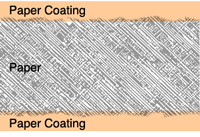 Exaggerated Side View Illustration | After manufacture, the uncoated paper surface may be coated with white clay materials. The clay gives the paper a smooth feel by filling minute valleys in the paper surface. The coating also limits the absorption of inks into the paper. Because the inks stay on the surface of the coating instead of soaking in, the ink looks deeper, sharper and glossier. However, writing and ballpoint pen inks may take longer to dry on coated paper and can smudge more easily. On coated stock, less ink is need to achieve the desired visual richness for text, images and photo's.
Coatings are offered in a range of reflectivity values including dull, matte, silk, satin or glossy. Reading long areas of text is easier when printed on dull or matt finishes. After printing images on dull or mat stock, a varnish can be applied to the picture areas to add gloss and make the pictures pop. |